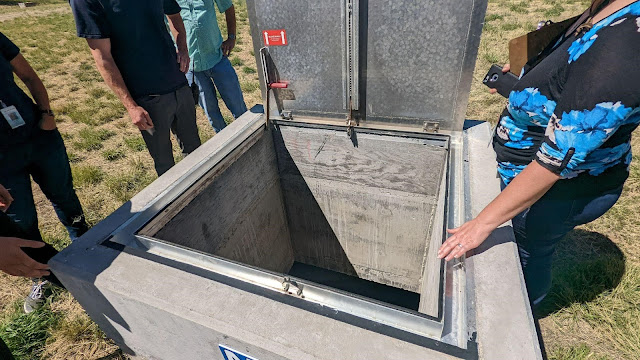Colorado promulgated the first-of-its-kind finished water storage tank rule in 2015. By and large, the public water system community has done an outstanding job in the last few years improving storage tank oversight, cleaning, and maintenance. Systems have also taken measures such as installing tank mixers at key locations in order to keep water fresh and maintain proper water quality throughout distribution. While everyone’s efforts are improving the protection of water quality by identifying and addressing potential pathways of contamination at tanks, this article focuses on a specific avenue that may allow for contaminants to enter protected water storage - flush-mounted roof hatches.
In subsequent years after the Storage Tank Rule went into effect, we have published a myriad of articles about finished water storage tanks, their importance, the purpose of the rule, key things to be planning for, and other guidance to help water systems stay on top of their storage tanks. To see just a sample of some of the articles we have published about storage tanks, follow these links:
Storage tank rule primer articles:
Prior to 2010, the division did not consistently review or approve storage tanks or storage tank appurtenances including hatches. We had published design criteria about roof hatch expectations (see Figure 1 below), but at the same time the division did not cite specific tank issues on design approvals. Therefore, for tanks designed and constructed prior to the 2000s, many different styles and types of hatches were installed and remain in use today. At this time, the department has identified challenges to provide adequate protection of tanks with the flush-mounted storage roof hatches installed outdoors. See Figures 2 and 3 below. The department has seen an uptick of significant deficiencies during sanitary surveys related to these flush mount systems installed outdoors.
Figure 1 - Excerpt from the Design Criteria for Potable Water Systems (2022 Edition) - Section 7.0.8.iii
At times, these outdoor hatches can be maintained and prevent contamination of the finished water as in the photos in Figures 2 and 3. However, the division has noted that properly maintained and protective flush-mounted tank hatches installed outdoors are more the exception than the rule. These hatches are not designed to keep contamination out of the tank in extreme weather conditions. The intrinsic hatch design has several key points of failure that need to be monitored quite frequently. During recent sanitary surveys that followed significant rain events, division staff observed points of failure in the hatches in question as shown in figures 4-7 below.:
Figure 4 - Flooded drain channel due to screen clogging - rainwater overwhelms the gasket and leaks into the storage tank as shown by the water mark due to drainage into the tank.
Figure 5 - Substantial insect activity in the drain channel - with insect intrusion and webs.
Figure 6 - Substantial insect activity inside a flush mounted hatch with webs and debris
Figure 7 - Evidence of a yellowjacket hornet nest inside the drainage channel - this can cause flooding of the hatch gasket and contamination
The Division recommends that systems proactively replace such hatches. At times, a second hatch can be mounted on the surrounding concrete to provide a proper seal and protect the finished water. However, on other occasions the hatch has to be completely replaced. As the storage tank rule enters its seventh year - there appears to be ample evidence that most flush-mount hatches do not provide a reliable seal for outdoor environments and must be carefully monitored and maintained. While they may be able to provide an adequate seal indoors, in the elements many points of failure make them arguably an unacceptable risk to public health.
The division will continue to communicate with the regulated community about our intention to cite these hatches that allow potential contamination as significant deficiencies each time we encounter them during sanitary survey site visits. However, don’t wait until your next sanitary survey to evaluate replacement as an proactive option to protect finished water and in the meantime, make sure to evaluate them during periodic inspections to ensure proper protections from contamination are in place. If you have any questions, please reach out to the Field Services Section at cdphe_wqcd_fss_questions@state.co.us or the Engineering Section at CDPHE.WQEngReview@state.co.us. Figure 8 demonstrates the proper hatch systems that should be installed on outdoor storage tanks.
Figure 8 - Ideal hatch design for outdoor installations








